Common menu bar links
Breadcrumb Trail
ARCHIVED - Public Safety and Emergency Preparedness Canada
 This page has been archived.
This page has been archived.
Archived Content
Information identified as archived on the Web is for reference, research or recordkeeping purposes. It has not been altered or updated after the date of archiving. Web pages that are archived on the Web are not subject to the Government of Canada Web Standards. As per the Communications Policy of the Government of Canada, you can request alternate formats on the "Contact Us" page.
Section II: Analysis of Program Activities
The following section describes Public Safety Canada’s strategic outcome and program activities, identifying expected results, performance indicators and targets for each.
A safe and resilient Canada
The Department’s mandate is legislatively defined as encompassing all matters related to public safety and emergency preparedness that have not been assigned to another department, board or agency. This mandate includes leadership at the national level over all matters pertaining to public safety and emergency management, including the leadership and coordination of the Public Safety Portfolio.
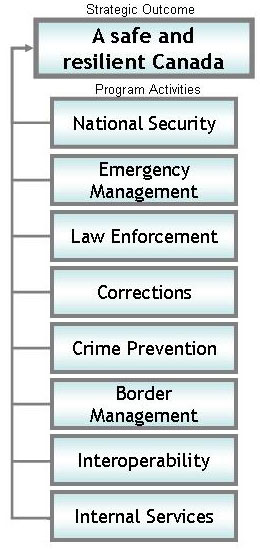
Although the use of “resiliency” in terms of gauging public safety is fairly new, this concept is becoming increasingly common. It can refer to the ability of a country to recover from a national disaster, the ability of critical infrastructure to avoid disruption, as well as the capacity of a community to recover from an incident which strains its social fabric. More recently, this concept has been used by several countries in the context of emergency management and the ability to measure resilience has been the object of an increasing number of studies.
In developing a framework to measure its strategic outcome, Public Safety Canada has already begun the process of engaging other countries, Provinces and Territories, and academia on how to effectively measure resilience. To date, the Department has met with several international partners and academic institutions and will continue this collaboration.
In the meantime, the Department will measure the pursuit of its strategic outcome through the assessment of the expected results and performance targets for the 2009-10 reporting period set out for each program activity; National Security, Emergency Management, Law Enforcement, Corrections, Crime Prevention, Border Management and Interoperability.
In particular, National Security will continue to strengthen Canada’s ability to combat espionage, terrorist activities and foreign-influenced activities by enhancing Canada’s National Security Framework, including developing a whole-of-government approach to cyber security, modernizing Canada’s legislative framework, and supporting the work of the Cross Cultural Roundtable on Security.
Emergency Management will continue to help ensure that Canadians are protected from major disasters, accidents and intentional acts; as well as work to enhance Canada’s critical infrastructure. Efforts include the implementation of the National Strategy and Action Plan for Critical Infrastructure, and leading federal consequence management preparations for the 2010 Olympic/Paralympic Games. Emergency Management will also continue to recognize the fundamental principle that individuals also have a responsibility to prepare for a range of emergencies through related programs such as the Emergency Preparedness Week and the 72 hours campaign.
Law Enforcement will strive for safe communities and effective policing through its efforts to strengthen the governance and accountability of the RCMP, and negotiate and renew police service agreements. This program activity will also focus on effective gun control and compliance measures, working with others to advance national efforts to combat serious and organized crime, and the effective delivery of the First Nations Policing Program.
Corrections will aim for the safe and effective reintegration of eligible offenders into Canadian communities by improving the effectiveness of the National Sex Offender Registry and pursuing correctional legislative reform. This program activity will also seek to ensure that Aboriginal communities have the knowledge and skills necessary to assume responsibility for corrections and healing and will work with other partners to help improve opportunities for Aboriginal communities.
Crime Prevention will work to ensure reduced offending among targeted populations, including children and youth at-risk and high risk repeat offenders. Planned activities include the administration of the National Crime Prevention Strategy; continued focus on the Youth Gang Prevention Fund and the National Anti Drug Strategy; the development and dissemination of practical knowledge on model programs; as well as the planned evaluation of the Communities at Risk: Security Infrastructure Pilot Program.
In its efforts to ensure efficient and secure borders while facilitating legitimate trade and travel, Border Management will focus on the development of a Canadian “border vision” for enhancing the management of Canada’s borders through improved risk management, effective engagement with the U.S. and targeted initiatives such as integrated cross-border maritime law enforcement initiatives identified through the Canada-U.S. Cross Border Crime Forum.
Interoperability efforts will focus on Information Management/Information Technology programs to enable preventative and/or emergency communication between federal departments and agencies in the interest of keeping Canadians safe. This will include the development of a system for classified e-mail (Secret Communications Network) across federal departments and agencies, and in collaboration with others, supporting the development of voice networks for first responders such as the Canadian Voice Interoperability Plan.
The above-mentioned program activities will be supported by the Internal Services program activity, which will concentrate on the ongoing improvement of the Department’s management tools and assisting managers and employees to respond to the findings of the Public Service Employee survey related to the Department; and the provision of strategic communications advice and services.
National Security
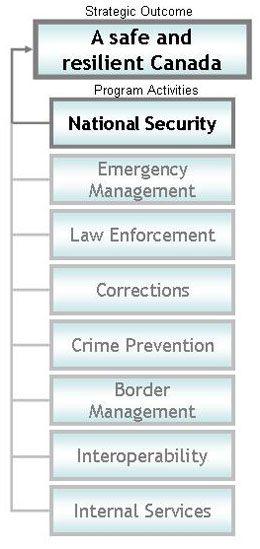
Benefit for Canadians
National Security strives for a safe and resilient Canada by working to ensure that Canada is better able to combat espionage, terrorist activities and foreign-influenced activities. The Department provides leadership in helping to protect Canada from national security threats through the development of policies, legislation and programs. It also works with partner departments and agencies to implement the Government’s direction on national security, while respecting the values of democracy, human rights and the rule of law.
| Human Resources (FTEs) and Planned Spending ($000’s) | ||||||||
|---|---|---|---|---|---|---|---|---|
| 2009-10 | 2010-11 | 2011-12 | ||||||
| FTEs | Planned Spending | FTEs | Planned Spending | FTEs | Planned Spending | |||
| 59 | 7,025.5 | 56 | 6,784.5 | 58 | 6,984.5 | |||
| Expected Result | Performance Indicators | Targets | ||||||
| Canada has a strong national security policy and legislative capacity | Relevant international and domestic partners are engaged to strengthen relationships regarding matters of national security |
≥ 5 International ≥ 20 Domestic |
||||||
| Development of policies and strategies to support operational activities | ≥ 3 | |||||||
| Existing reporting processes, such as the Department’s Performance Measurement Framework, mid-year reviews and year end reports will be used to inform the Department’s performance in achieving National Security’s expected results and reporting on associated performance indicators. | ||||||||
Canadians continue to live in an increasingly complex and uncertain world. Terrorist organizations continue to disrupt societies and claim innocent lives each year. The devastating events that most recently occurred in Mumbai, India on November 26-29, 2008 serve as a striking reminder that Canada and Canadians are not immune from terrorism whether or not it occurs within our borders.
National Security activities include the review of existing and the development of new policies and legislative proposals to ensure that Canada and Canadians are protected from new threats and challenges to national security, while balancing the need for oversight, accountability and the protection of civil liberties. The key Canadian values of democracy, human rights and respect for the rule of law are fundamental to Canada’s approach to national security.
Public Safety Canada participates in government efforts to protect Canadians from national security threats and to enhance national security through its advice to the Minister of Public Safety. This task involves working with numerous domestic and international partners, including agencies such as the Canadian Security Intelligence Service (CSIS), the Department of Justice and the RCMP. In 2009-10, the Department will provide advice to the Minister in support of the Government’s commitment to provide a civil right of action against perpetrators and sponsors of terrorism to victims of terrorism and establish a mechanism to review national security activities that involve more than one security agency.
In the coming year, the Department will also develop a government approach to cyber security. Efforts to modernize Canada’s legislative framework will continue in order to enable law enforcement and national security agencies to access information and lawfully investigate criminal and terrorist acts perpetrated through the illicit use of new technologies, or criminal and terrorist organizations using these technologies to further advance their cause.
The Cross-Cultural Roundtable on Security (CCRS) is mandated to engage Canadians and the Government of Canada in an ongoing dialogue on national security in a diverse and pluralistic society. In response to evaluation results, work will continue to improve the effectiveness and efficiency of the Roundtable throughout 2009-10. These adjustments include renewing the Roundtable’s membership through the rotation of members, the development of a formalized Roundtable outreach strategy, and the improved use of the Roundtable by Government to solicit feedback on policy and program proposals. These adjustments will help to ensure that the Roundtable remains a key contributor to the development of national security policies and programs that reflect the diverse views of Canadian society.
In 2009-10, the fourth and final memorial to the victims of the Air India Flight 182 tragedy will be completed and unveiled in Montreal.
Further information on the Department’s Program Activity Architecture (PAA) is available at http://www.publicsafety.gc.ca.
Emergency Management
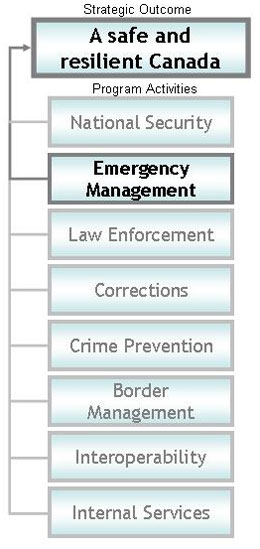
Benefit for Canadians
Emergency Management provides strategic direction and the coordination of emergency management activities before, during and after emergencies, ensuring that Canadians are better protected from major disasters, accidents and intentional acts.
Human Resources (FTEs) and Planned Spending ($000’s) |
||||||
|---|---|---|---|---|---|---|
| 2009-10 | 2010-11 | 2011-12 | ||||
| FTEs | Planned Spending | FTEs | Planned Spending | FTEs | Planned Spending | |
| 394 | 169,603.4 | 392 | 166,223.2 | 376 | 159,857.7 | |
| Expected Result | Performance Indicators | Targets | ||||
| Canadians are protected from all hazards (natural, technological and human induced), and Canada’s critical infrastructure is resilient | Percentage of Canadians who believe they are safer and better prepared to respond to natural and non-natural disasters | An increase of 6% by 2011-12 over 2008 baseline of 41% | ||||
| Percentage of Canadians who have prepared an emergency kit | An increase of 5% by 2011-12 over 2008 baseline of 43% | |||||
| Critical Infrastructure Resiliency Level | Development of a methodology to measure and assess resiliency by March 31, 2010 | |||||
| Existing reporting processes, such as the Department’s Performance Measurement Framework, mid-year reviews and year-end reports, will be used to inform the Department’s performance in achieving Emergency Management’s expected results and reporting on associated performance indicators. | ||||||
Through the implementation of the National Strategy and Action Plan for Critical Infrastructure, the Department will work with other federal lead departments to establish sector networks to share information and manage risks in each of the ten Critical Infrastructure (CI) sectors. The sector networks will be composed of relevant federal departments and agencies, Provinces, Territories and key members of the private and public sectors.
Critical infrastructure refers to processes, systems, facilities, technologies, networks, assets and services essential to the health, safety, security or economic well-being of Canadians and the effective functioning of government. Critical infrastructure can be stand-alone or interconnected and interdependent within and across provinces, territories and national borders. Disruptions of critical infrastructure could result in catastrophic loss of life, adverse economic effects, and significant harm to public confidence.
To support a comprehensive and collaborative public-private sector approach, Public Safety Canada will establish the National Cross-Sector Forum. This Forum will promote information-sharing across the sector networks and address cross-jurisdictional and cross-sectoral interdependencies.
The Department will continue leading the federal consequence management preparations for the 2010 Olympic/Paralympic Games. This includes ensuring that there will be consolidated reporting during the Games, coordinated federal government responses to incidents of interest and the processing of requests for assistance from federal or provincial authorities. Efforts will also involve planning in support of the National Chemical, Biological, Radioactive, Nuclear and Explosive Response Team (N CBNRE RT) in cooperation with key federal, provincial and municipal stakeholders.
Further information on the Department’s Program Activity Architecture (PAA) is available at http://www.publicsafety.gc.ca.
Law Enforcement
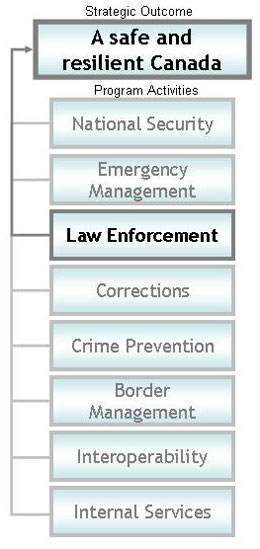
Benefit for Canadians
Law Enforcement contributes to the building of a safe and resilient Canada by working to ensure that Canada has safe communities and effective policing. By leading collaborative efforts with Portfolio agencies and federal, provincial, territorial and international partners in the law enforcement community, Public Safety Canada develops effective policies and law enforcement tools that assist in the fight against serious and organized crime, and support the operation and accountability of Canada’s national police force (Royal Canadian Mounted Police). The Department also recognizes the unique public safety challenges associated with participating First Nations and Inuit communities by providing funding to enhance provincial policing services through the First Nations Policing Program.
| Human Resources (FTEs) and Planned Spending ($000’s) | |||||||
|---|---|---|---|---|---|---|---|
| 2009-10 | 2010-11 | 2011-12 | |||||
| FTEs | Planned Spending | FTEs | Planned Spending | FTEs | Planned Spending | ||
| 126 | 126,412.0 | 126 | 126,749.0 | 126 | 126,697.3 | ||
| Expected Result | Performance Indicators | Target | |||||
| Canada has safe communities and effective policing | Percentage of Canadians who feel that their communities are safe | Baseline information under development | |||||
| Number of First Nations and Inuit communities that have access to the First Nations Policing Program | maintain at 399 communities or increase slightly | ||||||
| Existing reporting processes, such as the Department’s Performance Measurement Framework, Public Opinion Research and qualitative/quantitative indices will be used to inform the Department’s performance in achieving Law Enforcement’s expected results and reporting on associated performance indicators. | |||||||
In 2009-10, the Department will continue to provide sound policy advice to support the Minister in his responsibility and accountability for the RCMP. In particular, this will require leading collaborative efforts with the RCMP and other federal partners, Provinces and Territories, to respond to the recommendations of the Task Force on Governance and Cultural Change in the RCMP, those of Justice O’Connor’s 2006 report “A New Review Mechanism for the RCMP’s National Security Activities”, and other recent task force and Parliamentary Committee reports regarding the need to modernize the management, governance and accountability of the RCMP. A key element of this work in 2009-10 will be the advancement of a modernized and strengthened review and complaints body for the RCMP. In addition, in collaboration with the RCMP and TBS, Public Safety Canada will analyze options regarding an improved governance structure for the RCMP, including consideration of the establishment of a civilian board of management, as recommended by the Task Force on Governance and Cultural Change in the RCMP.
In 2007-08, Public Safety Canada received a mandate from the Government to negotiate and renew police service agreements with eight provinces, three territories and 180 municipalities for the provision of policing by the RCMP. Current agreements expire on March 31, 2012. The negotiation to renew these agreements will continue in 2009-10.
Public Safety Canada also provides strategic policy advice to the Minister on firearms issues. Priorities include new legislative and regulatory reforms that will focus on effective gun control and compliance measures that promote public safety and remove unnecessary administrative burdens. For example, working collaboratively with its partners, Public Safety Canada will support the Government’s intention to introduce new legislative amendments in 2009-10 to eliminate the requirement to register non-restricted firearms and the introduction of measures to incent compliance with the requirements of the Firearms Act.
The Department’s role in the fight against organized crime is one of policy development and coordination. Through the National Coordinating Committee on Organized Crime, Public Safety Canada brings together law enforcement agencies with federal, provincial and territorial partners to develop strategies and policies, ensuring a direct link between the law enforcement community and public policy makers. In 2009-10, the Department will strengthen the work of the National Coordinating Committee on Organized Crime, by developing strategies to tackle organized crime, including advancing the federal/provincial/territorial action plan against organized crime and, in collaboration with provinces and territories, strengthening witness protection in Canada.
Approximately 405 First Nations communities benefit from enhancements to provincial policing services through financial support offered by Public Safety Canada’s First Nations Policing Program (FNPP). To assess the program’s performance, the Department will use quantitative data and qualitative indices. Information including the number of officers, number of agreements, and population served will be assessed on an on-going basis, and reflected in the program evaluation that is proposed to be conducted in 2010-11.
To ensure the safety and security of the 2010 Olympic and Paralympic Games, Public Safety Canada will support collaborative efforts by confirming the level of preparedness and interoperability of security and safety operations among federal, provincial and municipal partners. To do so, the Department will utilize the Capability Review Management Framework (CRMF), which monitors and tracks the development of Olympic security related tasks. This Framework includes two reviews, the first will take stock of planning to date and identify operational gaps (to be completed prior to February 2009), and the second will lead to a declaration of preparedness by each participating department, agency or partner (to be completed prior to November 2009).
Further information on the Department’s Program Activity Architecture (PAA) is available at http://www.publicsafety.gc.ca.
Corrections
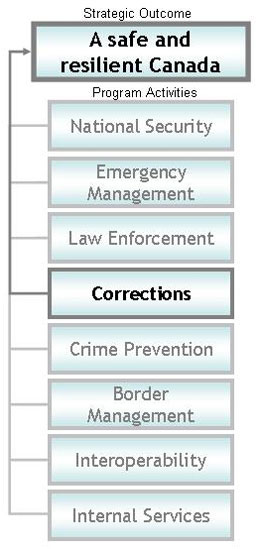
Benefit for Canadians
Corrections strives for a safe and resilient Canada by working with the Correctional Service of Canada to ensure the safe and effective reintegration of eligible offenders into Canadian communities. This program activity continually examines existing legislation to determine whether it remains relevant, needs to be modified or if new legislative tools are necessary to better protect Canadians. In addition, the Department manages programs that build capacity and assist in the effective community management and reintegration of eligible offenders, such as grant and contribution programs for criminal justice projects across Canada.
Human Resources (FTEs) and Planned Spending ($000’s) |
|||||||
|---|---|---|---|---|---|---|---|
| 2009-10 | 2010-11 | 2011-12 | |||||
| FTEs | Planned Spending | FTEs | Planned Spending | FTEs | Planned Spending | ||
| 29 | 7,411.4 | 27 | 7,040.6 | 27 | 7,040.6 | ||
| Expected Result | Performance Indicators | Targets | |||||
| Safe and effective reintegration of eligible offenders into Canadian communities | Percentage of successful statutory releases reported by the annual Departmental Corrections and Conditional Release Statistical Overview | ≥ 58% | |||||
| Aboriginal communities have the knowledge and skills necessary to assume responsibility for corrections and healing | Number of First Nations, Métis, Inuit or urban Aboriginal communities that are ready to assume responsibility for corrections and healing | 50% increase in Aboriginal communities (increase to 8 communities, from 4 in 2008-09) | |||||
| Existing reporting processes, such as the Department’s Performance Measurement Framework will be used to inform the Department’s performance in achieving Corrections’ expected results and reporting on associated performance indicators and targets. | |||||||
In 2009-10, proposals will be examined to strengthen the effectiveness of the National Sex Offender Registry as a tool for use by police and to enhance public safety. Reporting on the expected results will be based on input from the police community regarding their use of the Registry and its impact on their investigation of crimes of a sexual nature.
Corrections will pursue an ongoing program of correctional legislative reform proposals. This program supports the Minister’s national leadership role for correctional issues and contributes to the successful reintegration of eligible offenders in Canadian communities. Program success is measured by the success rates for offenders on conditional release as reported by the annual Departmental Corrections and Conditional Release Statistical Overview.
The Department will continue work to improve opportunities for Aboriginal communities to assume greater responsibility for the treatment of offenders, victims and their families within traditional healing and wellness processes. This initiative will provide information and advice to Aboriginal communities to inform their decisions on whether or not to assume responsibility for corrections and healing through the publication of up to three reports/evaluations, participation at up to ten community meetings and at least two conferences.
Finally, the development of evidence-based best practices that reduce offender recidivism and enhance public safety will be achieved through empirical studies aimed at improving offender assessment tools and intervention practices. Program success is measured by adoption of the new developed risk instruments and interventions by our provincial/territorial and federal partners.
Further information on the Department’s Program Activity Architecture (PAA) is available at http://www.publicsafety.gc.ca.
Crime Prevention
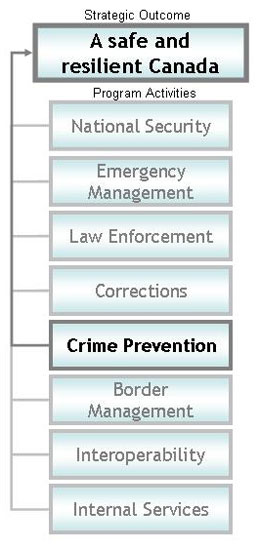
Benefit for Canadians
Crime Prevention supports the pursuit of a safe and resilient Canada by working to ensure reduced offending among targeted groups of the population, especially at-risk children and youth and high risk repeat offenders. By providing national leadership on effective and cost-efficient interventions that address known risk factors related to offending, Public Safety Canada contributes to the adoption of effective crime prevention in Canadian communities. The Department develops and disseminates policies, practical knowledge, and manages funding programs that support community-based crime prevention projects through time-limited grants and contributions.
| Human Resources (FTEs) and Planned Spending ($000’s) | |||||||
|---|---|---|---|---|---|---|---|
| 2009-10 | 2010-11 | 2011-12 | |||||
| FTEs | Planned Spending | FTEs | Planned Spending | FTEs | Planned Spending | ||
| 96 | 64,434.7 | 96 | 64,434.4 | 86 | 57,238.6 | ||
| Expected Result | Performance Indicators | Targets | |||||
| Reduced offending among targeted populations (youth at-risk and high risk repeat offenders) | Percentage of approved project proposals that use evidence based information when developing an intervention for children and youth at risk and high risk repeat offenders | ≥ 80% | |||||
| Number of at risk individuals who participated in National Crime Prevention Centre funded programs | Baseline information under development | ||||||
| In order to report on results, the Department will use a custom designed information management system that captures a wide variety of data on projects being submitted to the grants and contribution programs at Public Safety Canada’s National Crime Prevention Centre. The system is designed to provide information to assist with monitoring, reporting and knowledge development. In addition to this system, the Department will utilize other internal mechanisms that track results, such as audits and impact assessments of selected projects. | |||||||
Public Safety Canada, in collaboration with Provinces and Territories, administers the National Crime Prevention Strategy (NCPS), which constitutes the framework for the national crime prevention program. In Budget 2008, the Government of Canada increased its permanent funding by $30M, bringing the total ongoing funding for the NCPS close to $63M per year. This increase in resources reflects the Government’s commitment to include effective crime prevention as part of its response to crime and public safety.
For the planning period 2009-10, Public Safety Canada will emphasize the development and dissemination of practical knowledge on, and promote the implementation of, model crime prevention programs across Canada. To achieve this, the Department will fund multi-year targeted interventions focusing, in particular, on the following priority groups:
- children aged 6-11 years, to prevent their initiation in criminal activity, from the point at which there are early signs of anti-social behaviour;
- young people aged 12-17, to reduce the pressures brought about by known risk factors among those who are the most susceptible to crime, including those who have been in trouble with the law; and
- young adults aged 18-24, particularly those who have a history of offending.
In addition, the Department will monitor the implementation of evidence-based interventions under the Youth Gang Prevention Fund designed to prevent youth from joining gangs and to support their exiting from gangs. The Fund supports multi-year projects in selected communities to help direct vulnerable youth toward jobs, education and positive social activities.
As a partner in the prevention pillar of the National Anti Drug Strategy, Public Safety Canada will also continue to direct a portion of crime prevention funds to support evidence-based projects that enhance the presence of protective factors and reduce risk factors most closely linked to substance abuse and related crime.
Public Safety Canada also administers the Communities at Risk: Security Infrastructure Pilot Program. This program seeks to improve the safety of communities at risk of hate-motivated crime by providing support to enhance security infrastructure for those not-for-profit organizations central to any community, including: provincially-recognized educational institutions, places of worship, and community centres. Working in partnership with Canadian communities, the pilot program will distribute just over $1.5 million to recipients by the end of fiscal year 2008-09. The program will be evaluated in 2009-10 to help determine the need for, and viability of, this program over the longer term, as well as its contribution to tackling crime and building safer communities.
Further information on the Department’s Program Activity Architecture (PAA) is available at http://www.publicsafety.gc.ca.
Border Management
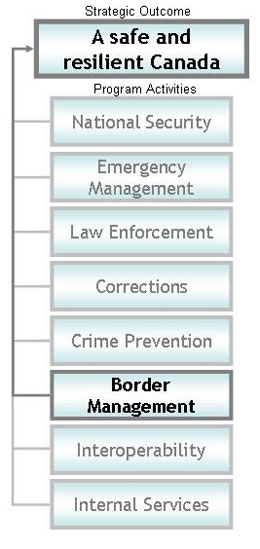
Benefit for Canadians
Border Management supports a safe and resilient Canada by working to ensure efficient and secure borders which facilitate legitimate trade and travel. Efficient and secure borders are essential to our national security and economic well-being: Public Safety works with key stakeholders (CBSA, RCMP, CSIS, Citizenship and Immigration Canada, Transport Canada, the Department of Foreign Affairs and the U.S.) to keep threats out of Canada, while facilitating cross-border trade that is critical to Canada’s economy.
Human Resources (FTEs) and Planned Spending ($000’s) |
||||||
|---|---|---|---|---|---|---|
| 2009-10 | 2010-11 | 2011-12 | ||||
| FTEs | Planned Spending | FTEs | Planned Spending | FTEs | Planned Spending | |
| 19 | 2,093.4 | 18 | 2,103.4 | 18 | 2,014.1 | |
| Expected Result | Performance Indicators | Targets | ||||
| Efficient and secure borders which facilitate legitimate trade and travel | Percentage of border wait times (people and goods) standards that are achieved | Baseline information under development | ||||
| Number of people refused entry to Canada and/or removed from Canada | Baseline information under development | |||||
| Existing reporting processes, such as the Department’s Performance Measurement Framework, will be used to inform the Department’s performance in achieving Border Management’s expected results and reporting on associated performance indicators. | ||||||
Effective border management is best achieved through adequate and well-placed infrastructure; the development and use of technologies; risk-based programs, protocols and procedures; and seamless, cooperative enforcement. As such, the Department leads collaborative efforts with Portfolio agencies, as well as other government departments and the United States, on policies, initiatives and strategies to support border security measures and cooperative arrangements.
In support of its expected result, departmental priorities for the Border Management program activity in 2009-10 involve the development of a Canadian ‘border vision’ for enhanced border management. The implementation of this vision will be based on the pursuit of specific border security and facilitation initiatives. Program success will be measured by the effectiveness of border initiatives in contributing to the security, competitiveness and economic well-being of both Canada and the United States.
In 2009-10, Public Safety Canada will focus on the development and implementation of a framework agreement to govern integrated cross-border maritime law enforcement operations, also known as Shiprider. This will promote the deployment of seamless, continuous law enforcement operations at the border as well as maximize the use of existing resources to secure the border. Milestones will include finalizing negotiations on an agreement with the U.S., tabling the agreement in Parliament for review, and developing and proposing legislation to support the agreement’s ratification.
With a view to further enhancing border integrity (and with a particular emphasis on stemming the illegal flow of guns into Canada), the Department will work collaboratively with Portfolio and other federal partners, as well as provincial counterparts, to advance options for a pilot project in the province of Québec to patrol unguarded roads and marine crossings between Canada and the U.S.
The Canada-U.S. Cross Border Crime Forum (CBCF) brings together Canadian Ministers of Public Safety and Justice, the U.S. Attorney General, the U.S. Secretary of Homeland Security, as well as over 120 Canadian and U.S. senior government officials, with a view to resolving cross-border law enforcement and justice operational and policy impediments. The next CBCF will be hosted by the U.S., and is expected to be held in the fall of 2009. Public Safety will coordinate Canadian efforts and collaborate with U.S. officials on joint threat assessments (e.g., border enforcement), joint analysis (e.g., firearms trafficking), collaborative law enforcement pilot projects (e.g., interoperability and personnel exchanges) as well as report on joint cross-border law enforcement investigations. Additionally, the 2009 CBCF will include items related to the 2010 Vancouver Olympics.
The Department will engage the new U.S. administration on bilateral cross-border emergency management cooperation and commitments made during the North American Leaders’ Summits held in Montebello and in New Orleans. This includes implementation of the Canada-U.S. Strategic Protocol for Managing the Movement of Goods and People During and Following Emergencies.
Further information on the Department’s Program Activity Architecture (PAA) is available at http://www.publicsafety.gc.ca.
Interoperability
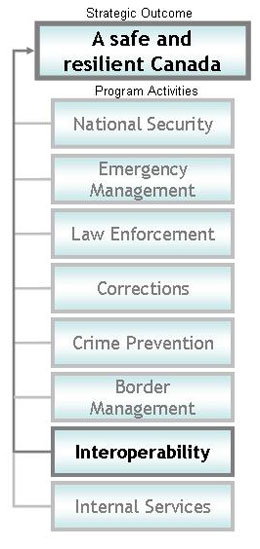
Benefit for Canadians
Interoperability supports the establishment of a safe and resilient Canada by working to ensure that information regarding public safety and security objectives is shared in a secure, integrated and timely manner. Within the public safety and security sector, interoperability refers to ensuring that government agencies and organizations can share the right information at the right time to keep Canadians safe. Accordingly, Public Safety Canada leads collaborative efforts with public safety partners to develop policies, initiatives and strategies that address information-sharing and interoperability gaps in order to enhance national security, emergency management response and public safety for Canadians.
| Human Resources (FTEs) and Planned Spending ($000’s) | |||||||
|---|---|---|---|---|---|---|---|
| 2009-10 | 2010-11 | 2011-12 | |||||
| FTEs | Planned Spending | FTEs | Planned Spending | FTEs | Planned Spending | ||
| 15 | 3,456.9 | 15 | 3,456.9 | 15 | 3,456.9 | ||
| Expected Result | Performance Indicators | Targets | |||||
| Information regarding public safety and security objectives is shared in an integrated and timely manner | The number of participating public safety and security departments and agencies involved in interoperability and information-sharing | ≥ 26 | |||||
| Existing reporting processes, such as the Department’s Performance Measurement Framework, will be used to inform the Department’s performance in achieving Interoperability’s expected results and reporting on associated performance indicators. | |||||||
In support of its expected result, departmental priorities for the Interoperability program activity in 2009-10 will focus on the development of technological and policy solutions to facilitate the sharing of information in a timely, secure and integrated manner across the federal public safety and security sector. In support of the Cyber Security strategy, Continuity of Constitutional Government, Emergency Management and to address gaps identified by the Office of the Auditor General regarding the security of information exchanged amongst federal government departments, Public Safety Canada will coordinate efforts with interested departments to identify options to sustain the Secret Communication Network for the 2009-10 fiscal year and develop a proposal to obtain long-term funding for its operation.
To help address gaps in Canadian voice interoperability, including the findings of the Senate Committee on National Security and Defence Report, “Emergency Preparedness in Canada”, the Department will support collaborative efforts with its public safety partners (e.g. RCMP) to develop and advance a national strategy for the Canadian Voice Interoperability Plan, including the identification of necessary requirements to enable interoperable communications with first responders.
To better coordinate interoperability efforts, the Department will continue to actively engage public safety and security partners in an on-going dialogue to identify opportunities for improved information-sharing, and to develop and implement interoperable solutions. To do so, a gap analysis report will be created and monitored on an annual basis.
Further information on the Department’s Program Activity Architecture (PAA) is available at http://www.publicsafety.gc.ca.
Internal Services
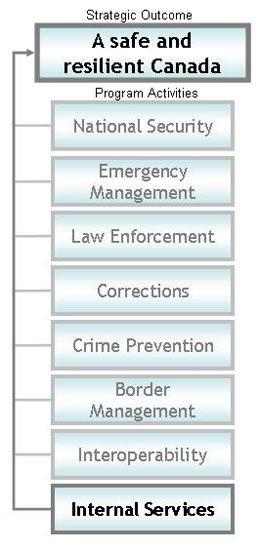
| Financial Resources ($000’s) | ||
| 2009-10 | 2010-11 | 2011-12 |
| 45,536.7 | 45,165.6 | 44,035.5 |
| Human Resources (Full-Time Equivalents) | ||
| 2009-10 | 2010-11 | 2011-12 |
| 354 | 354 | 354 |
During 2008-09, Public Safety Canada conducted a review of the alignment of its resources and priority activities and identified several areas of key management focus that could be further reviewed and adjusted in 2009-10.
In 2009-10, Public Safety Canada will continue to build internal policy, program and administrative capacity in key areas. The Department will continue to strengthen relationships, internally within the Portfolio, and with other departments and Central Agencies.
Public Safety Canada will analyze the findings of the 2008 Public Service Employee Survey to gauge progress made by the Department since the 2005 survey and to identify areas requiring attention. Collected human resources information will allow managers to identify priority areas and address survey findings. Accordingly, the Department will determine the necessary initiatives, such as programs, policies, tools, etc., required to respond to any potential workplace challenges raised by employees. These initiatives will form an integral part of the Department’s human resources and business planning processes for the 2010-11 fiscal year.
The Department will be strengthening its internal audit function by continuing the implementation of its Internal Quality Assurance and Improvement Program and establishing a Departmental Audit Committee comprised of members drawn from outside the public service.
Public Safety Canada continues to improve the resiliency and security of Information Management/Information Technology (IM/IT) infrastructure through a continuous risk management program that includes threat and risk assessments and vulnerability assessments, an active awareness and training program and an incident management program that will blend with government-wide incident management. Ongoing efforts are required to ensure the continued and consistent application of IM/IT security measures, such as the continued implementation of its Business Continuity Plan to ensure that the Department will be able to respond to disruptions.
Public Safety Canada will begin the implementation of a corporate evaluation function that will ensure that the Department is compliant with policies, standards and directives related to evaluation. A departmental evaluation committee will be formed to support, oversee and monitor the evaluation function and management accountabilities arising from evaluations and evaluation-related products. The evaluation function will be operational by end of fiscal year 2009-10.
In 2009-10, Public Safety Canada will continue to advance the implementation of the Management, Resources and Results Structure (MRRS) policy. Key initiatives include the finalization of the Department’s Performance Measurement Framework (PMF) and the development of key performance measures for the Department’s strategic outcome. The Department will also improve the mechanisms used for performance management across the Department. Its focus will be on providing managers timely access to performance information needed to make effective business decisions and will facilitate the Department’s ability to report on results externally to the Treasury Board Secretariat, Parliamentarians and the public in general.
Building on last year’s success, Public Safety Canada will refine its Integrated Human Resources and Business Plan. The 2009-10 plan will benefit from a refined process and will depict increased integration of human resources, financial and business planning activities. The Department will also finalize the development of its risk management framework. In 2008-09, Public Safety Canada began the initial drafting of an Integrated Risk Management Framework and Policy. In 2009-10 the Department will work to finalize the framework and policy and develop a corporate risk profile.
Further information on the Department’s Program Activity Architecture (PAA) is available at http://www.publicsafety.gc.ca.
